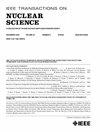lpGBT:用于高能物理实验的低功率抗辐射多用途高速收发芯片
IF 1.9
3区 工程技术
Q3 ENGINEERING, ELECTRICAL & ELECTRONIC
引用次数: 0
摘要
欧洲核子研究中心的高亮度大型强子对撞机(HL-LHC)探测器系统的调试计划在2026年至2028年之间进行。用于这些系统的专用集成电路(asic)在过去十年中得到了激烈的发展。其中一些asic,如本工作中描述的低功率千兆收发器(lpGBT)的情况,现在已经在工业批量生产,并且已经完全符合在HL-LHC环境中运行的要求,其中最内部的探测器涉及的辐射硬度超过1 MGy。lpGBT是一种多功能设备,可以在检测器和检测器系统之间进行数据传输。数据可以以5.12和10.24 Gb/s的速度从检测器传输,以2.56 Gb/s的速度传输到检测器。它实现了数据速率可配置的电气链路,与前端asic和低速串行和并行总线通信,用于实验控制。还包括一组用于监测和控制物理探测器的模拟函数。本文介绍了lgbtasic的功能和结构,并报道了其辐射硬度特性。本文章由计算机程序翻译,如有差异,请以英文原文为准。
lpGBT: Low-Power Radiation-Hard Multipurpose High-Speed Transceiver ASIC for High-Energy Physics Experiments
Commissioning of detector systems for the high-luminosity large Hadron collider (HL-LHC) is scheduled to take place between 2026 and 2028 at CERN. Application-specific integrated circuits (ASICs) for those systems have been in intense development over the past ten years. Some of those ASICs, as is the case of the low-power gigabit transceiver (lpGBT) described in this work, have now been produced in industrial quantities and have been fully qualified for operation in the HL-LHC environments that require, where the innermost detectors are concerned, radiation hardness over 1 MGy. The lpGBT is a multifunctional device, enabling data transmission between the off-detector and the on-detector systems. Data can be transmitted from the detector at 5.12 and 10.24 Gb/s and to the detector at 2.56 Gb/s. It implements data rate-configurable electrical links to communicate with the front-end ASICs and low-speed serial and parallel buses for experiment control. A set of analog functions for monitoring and control of the physics detectors is also included. This article describes the functionality and the architecture of the lpGBT ASIC and reports on its radiation hardness characterization.
求助全文
通过发布文献求助,成功后即可免费获取论文全文。
去求助
来源期刊

IEEE Transactions on Nuclear Science
工程技术-工程:电子与电气
CiteScore
3.70
自引率
27.80%
发文量
314
审稿时长
6.2 months
期刊介绍:
The IEEE Transactions on Nuclear Science is a publication of the IEEE Nuclear and Plasma Sciences Society. It is viewed as the primary source of technical information in many of the areas it covers. As judged by JCR impact factor, TNS consistently ranks in the top five journals in the category of Nuclear Science & Technology. It has one of the higher immediacy indices, indicating that the information it publishes is viewed as timely, and has a relatively long citation half-life, indicating that the published information also is viewed as valuable for a number of years.
The IEEE Transactions on Nuclear Science is published bimonthly. Its scope includes all aspects of the theory and application of nuclear science and engineering. It focuses on instrumentation for the detection and measurement of ionizing radiation; particle accelerators and their controls; nuclear medicine and its application; effects of radiation on materials, components, and systems; reactor instrumentation and controls; and measurement of radiation in space.
 求助内容:
求助内容: 应助结果提醒方式:
应助结果提醒方式:


